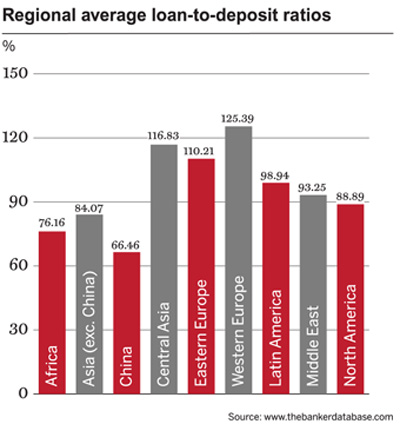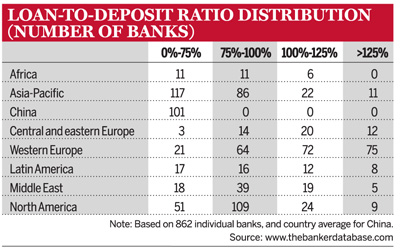Banks' prudent funding strategies have played a key role in keeping some lenders safe during the financial crisis. To fund lending activities mainly through deposits is a prudent strategy – as opposed to short-term capital markets fundraising products – and the loans-to-deposits (LTD) ratio provides an indication of how exposed to alternative funding strategies banks are.
Out of the 862 banks sampled by The Banker, western European lenders had the highest regional average LTD figure at 125.39%. It is closely followed by central Asian banks with an average 116.83% ratio, and eastern European lenders with 110.21%. The lowest ratio is found in China, where loans are on average two-thirds the value of deposits (66.46%).
Comparison with last year’s findings is not appropriate as the volume of data collected this year is more than three times higher than 2010's listing.
Western Europe is also the region with the largest number of banks to have an LTD ratio in excess of 100% (72 banks fall in the 100% to 125% bracket while 75 banks are in the over 125% bracket). North America has 24 banks which display an LTD ratio of between 100% and 125%, while central and eastern Europe has only 12 lenders with a ratio above 125%. All Chinese banks have an LTD ratio of less than 75% as local regulation forces bank loans to be significantly lower than the value of retail deposits as these are not insured in the country.
Elsewhere, regulators’ continuous pressure to develerage banks and keep them away from short-term capital markets funding has had an impact on LTD ratios. In the UK, for example, such regulatory pressures have resulted in a bank levy. This levy was introduced at the beginning of this year and will tax banks’ liabilities at 0.075%, with the exclusion of Tier 1 capital, insured retail deposits and some other debt.
But if high LTD ratios can be risky, too low values can also be detrimental because they indicate that the bank is not lending as much as it could, and therefore is not as profitable as it should be.
High LTD ratios can be found in fast-growing markets but not in the top 25 world's banks, with the exception of BNP Paribas, Lloyds, UniCredit and Groupe BPCE, which have LTD figures of around or above 125%. All of these banks are from western Europe.







